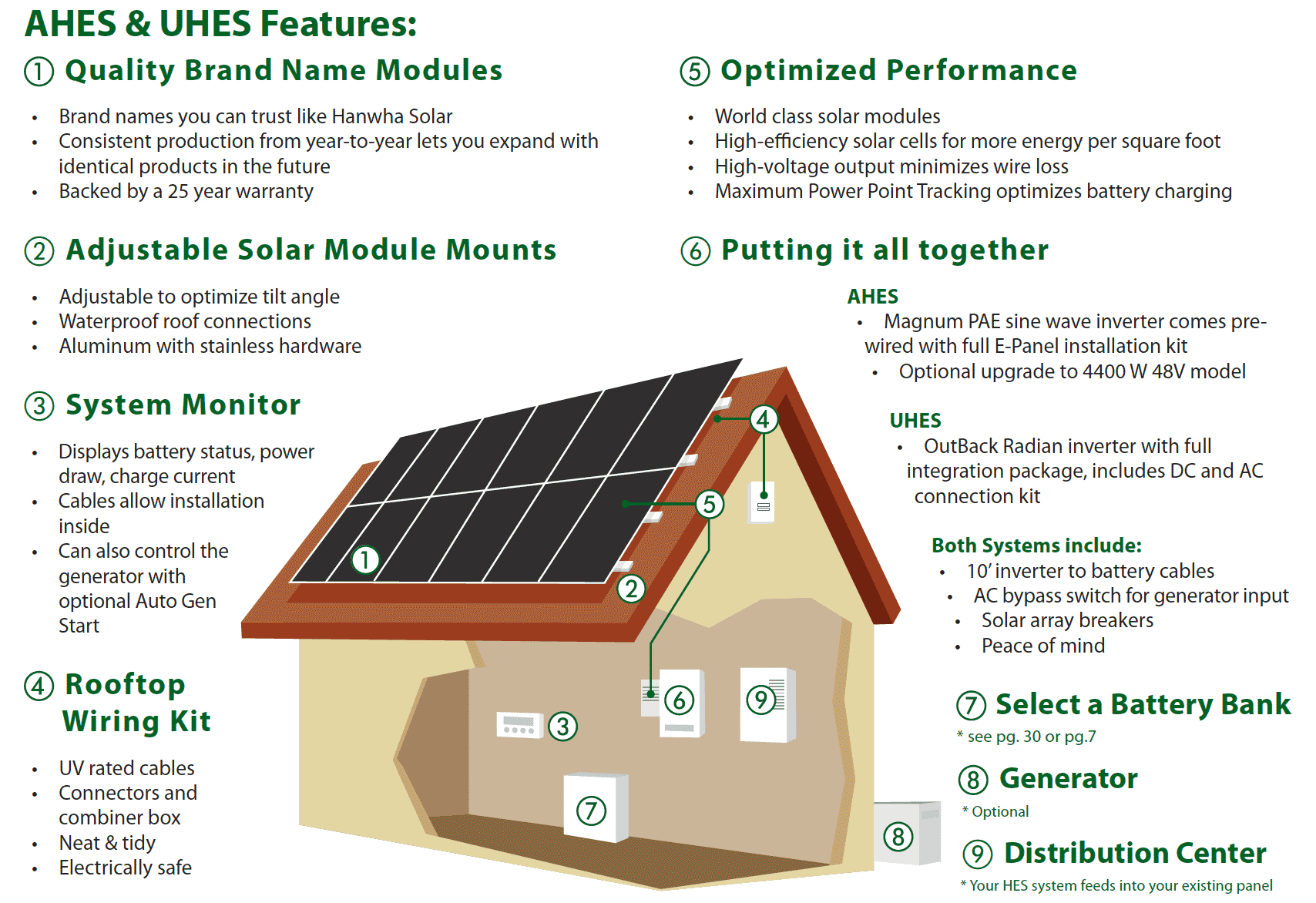Explain Off-Grid Solar Systems to me. What could it do for me?
Solar can be used to provide the majority or all of the power in a remote cottage or home. Ideally, the solar system is designed by a professional to match your lifestyle and electrical load. The systems are modular so they can grow as your power needs change. Off-grid solar systems have storage batteries, and often have generators for back- up. The inverter systems for off-grid applications have built-in battery chargers, and can even be used to start the generator automatically if needed.
What do I need to know about Inverters?
Most inverters used in off-grid solar systems connect directly to the AC load centre, and therefore energize the whole house. The inverter output is either a modified sine wave (cheaper) or a sine wave (cleaner). Other features to compare are charger size, efficiency and warranty.
What do I need to know about Batteries in Off Grid Solar Systems?
Batteries are your gas tanks. Deep cycle batteries are recommended as they can handle deeper discharges better. Flooded cells offer the best value. 6V batteries like the Surrette S-600 are popular for smaller systems, and larger, industrial Big Red cells are used when more capacity and life are needed. Proper charging and limiting discharging is the key to long battery life.
How big a solar system do I need?
The PV and battery system are sized to meet your power needs. A qualified installer will review your electrical loads and help you select the right equipment. For a full-time home, a 1kW system will deliver on average 1.5 kWh per day in December, and about 4.5 kWh in the summer. Note that you can increase your solar system size at any time as your needs grow. However, it is wise to select a larger battery initially as it must be replaced rather than expanded due to the general rule about not mixing old and new batteries.
Why do I need a charge controller and which one is right for me?
In the simplest case, charge controllers limit the solar power going to the batteries so they don’t overcharge. Series Controllers do this with a relay that is opened after a certain battery voltage is reached. This is the simplest and cheapest route. PWM Controllers taper the current to the battery as the voltage rises through Pulse Width Modulation of the energy input. This is better for battery life as it adds a float charge to keep batteries at 100% full. Larger solar arrays use MPPT Charge Controllers. Maximum Power Point Tracking circuits monitor solar panel current, voltage and temperature and get the maximum amount of power they can out of the solar array. This type of controller works with all voltage panels and can accept high-voltage input while charging a low-voltage battery, allowing you to wire panels in series rather than parallel. MPPT controllers are more expensive, but the extra energy harvest is usually worth it..
What is the optimum angle to mount the solar panels?
In Canada, the optimum tilt angle is equal to latitude + 15 degrees for winter output, and latitude – 15 degrees for summer output. That being said, 10 to 15 degrees off the optimum does not have much impact on production. If the off-grid project is seasonal (like a summer cottage) a tilt angle that matches the roof slope is usually acceptable. For a full-time home, solar panels tend to be steeper. This helps shed snow and maximizes winter production when the solar insolation is at its lowest.
What do I need to run a refrigerator?
A refrigerator is one of the most essential appliances in a home, and one of the more significant electrical loads. However, the best Energy Star-rated refrigerators today can consume as low as 1.3 to 1.5 kWh per day. Older fridges and freezers required 3 to 4 kWh per day, making them very difficult to run with a battery system. It takes about 1.5 kW of PV panels to deliver 1.5 kWh of power in December, so you can mate a good fridge and 6 250W solar panels for year-round use. If the fridge is only used seasonally, say from April through October, then a 3-module system should deliver approximately the right amount of power. Our advice - is to buy the fridge based on its EnerGuide rating - the lower the consumption the easier on the power system.
